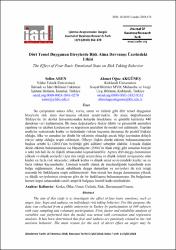Dört Temel Duygunun Bireylerde Risk Alma Davranışı Üzerindeki Etkisi
Abstract
Bu çalışmanın amacı öfke, korku, umut ve üzüntü gibi dört temel duygununbireylerin risk alma davranışına etkisini araştırmaktır. Bu amaç doğrultusundaTürkiye’de bir devlet üniversitesinden kolayda örnekleme ve gönüllü katılımla 440denekten veri toplanmıştır. İlk önce değişkenlere ilişkin faktör ve güvenirlik analizleriyapılmış ve takiben korelasyon ve regresyon analizleri ile model test edilmiştir. Yapılananalizler neticesinde korku ve üzüntünün riskten kaçınma davranışı ile pozitif ilişkideolduğu, öfke ve umudun ise direkt bir etkisinin olmadığı ancak bilgi üzerinden dolaylıetkiye sahip olduğu tespit edilmiştir. Öfkeye ilişkin direkt etkinin bulunamamasınınbaşlıca sebebi Li (2011)’nin belirttiği gibi kültürel sebepler olabilir. Umuda ilişkindirekt etkinin bulunamaması ise Hayenhjelm (2006)’in ifade ettiği gibi umudun bireyino anki ruh hali ile de ilişkili olmasından kaynaklanabilir. Ayrıca dört duygu durumununyüksek ve düşük seviyeleri için risk isteği araştırılmış ve düşük üzüntü seviyesinde olankişiler en fazla risk isteyenler, yüksek korku ve düşük umut seviyesindeki kişiler ise enfazla riskten kaçınanlardır. Cinsiyet temelli olarak da incelendiğinde kadınlarda aynıbulgu sağlanmıştır. Ancak erkeklerde duygu durumları ve seviyeleri ile risk isteğiarasında bir farklılaşma tespit edilememiştir. Son olarak her duygu durumunun yüksekve düşük seviyelerinde cinsiyete göre de bir farklılaşma bulunamamıştır. Bu bulgularınhemen hepsi sahasındaki sınırlı ampirik bulguya önemli katkı nitelindedir. The aim of this study is to investigate the effect of four basic emotions, such as anger, fear, hope and sadness, on individuals risk taking behavior. For this purpose, the data was collected from a public university in Turkey by participation of 440 subjects with easy sampling and voluntary participation. First, factor and reliability analysis of variables was performed then the model was tested with correlation and regression analysis. It has been determined that fear and sadness are positively related to the risk aversion behavior. The main reason for the lack of direct effect on anger may be cultural reasons as Li (2011) points out. As Hayenhjelm (2006) states, the absence of direct influence on hope can result from the fact that hope is related to the individual's current mood. In addition, risk propensity for high and low levels of four emotional states was investigated. Those who are at low sadness level demand the most risk, those with high fear and low hope level are the ones who avoid the most risk. When examined on gender-based, the same finding was also found for women. However, in males, no differentiation was found between emotional states and risk propensity. Finally, there was no differentiation in sex at each of the high and low levels of each emotional state. Almost all of these findings are significant contributors to the limited empirical finding.
Source
İşletme Araştırmaları DergisiVolume
10Issue
3URI
https://doi.org/10.20491/isarder.2018.478https://app.trdizin.gov.tr/makale/TXpBMU9EWTNOdz09
https://hdl.handle.net/20.500.11857/1770



















